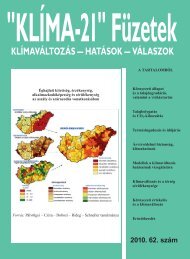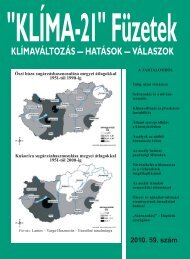KLÃMA-21 Füzetek 61. szám - VAHAVA Hálózat
KLÃMA-21 Füzetek 61. szám - VAHAVA Hálózat
KLÃMA-21 Füzetek 61. szám - VAHAVA Hálózat
You also want an ePaper? Increase the reach of your titles
YUMPU automatically turns print PDFs into web optimized ePapers that Google loves.
„KLÍMA-<strong>21</strong>” FÜZETEK: KLÍMAVÁLTOZÁS – HATÁSOK – VÁLASZOK 189<br />
The <strong>VAHAVA</strong> report states that the average global temperature is rising and that the distribution<br />
of precipitation in time and space is undergoing a dramatic change, which might cause local<br />
floods and elevated ground water table (see the groundwater floods in 2010). Considering<br />
that most of the waters in Hungary come from abroad – primarily from the Carpathian Basin<br />
– it is necessary for all countries involved to cooperate responsibly in the field of water management.<br />
Overall, Hungary meets the EU expectations at the level of the Catchment Management<br />
Plan, but this is little solace when it comes to water used for agriculture in the country.<br />
FRUIT SECURITY<br />
By<br />
SOLTÉSZ, MIKLÓS – SZABÓ, ZOLTÁN – NYÉKI, JÓZSEF<br />
Keywords: fruit production, security, risk, conditions, tasks.<br />
Strategic tasks to improve the security of fruit production in Hungary:<br />
1. Organic and integrated fruit production is becoming more and more competitive globally,<br />
with energy and water efficient solutions being increasingly preferred. Therefore the<br />
actions directed at improving crop security should also promote the wider adoption of these<br />
production methods in Hungary.<br />
2. More than two thirds of all fruit-growing areas are permanently located at the plains.<br />
Consequently, the solutions for improving crop security should target the areas of the plains.<br />
3. Identification and utilisation of optimal growing sites is becoming more and more important.<br />
Fruit cadastres should be transferred to a new basis. Based on local weather data, the<br />
risks of extreme weather having a profound effect on the production of the envisaged fruit<br />
species should be identified on the level of individual plots.<br />
4. Decisions on the protection measures and technology to be used to prevent the effects of<br />
extreme weather should be taken by the producers at the level of individual plots, taking into<br />
account the value of the assets to be protected and the costs of protection measures.<br />
5. Producer organisations, professional and advocacy groups should facilitate the introduction<br />
of community-based protection methods wherever necessary and feasible.<br />
6. As a way of protecting the common interests of the society, the government and its<br />
bodies should support the improvement of fruit security in the country, with special emphasis<br />
on protection from the consequences of extreme weather. In addition to financial support, this<br />
should also include legal measures, which should be formulated with regard to the final goal,<br />
rather than use stereotyped solutions. It is therefore not expedient to restrict aid to only one<br />
method of protection against hail or frost damage.<br />
7. Innovation aimed at increasing crop security should be made a priority and should be<br />
encouraged through specific support measures. Only this way will producers have timely access<br />
to tools and information required to prevent the consequences of extreme weather or to<br />
reduce the loss sustained.<br />
8. The strategic tasks listed above are urgent for preserving competitiveness, as other<br />
countries have already paid much attention to improving crop security, and have made serious<br />
sacrifices in order to prevent the negative consequences of extreme weather.






